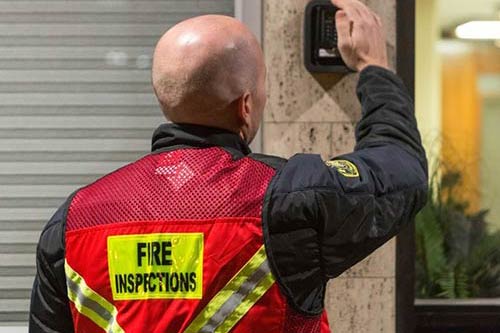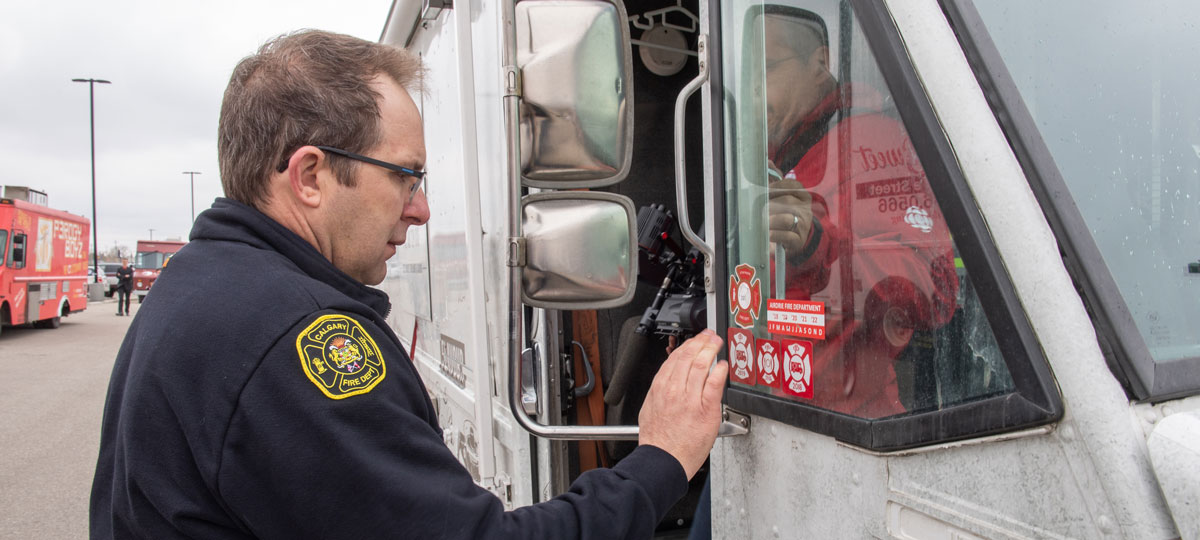Fire Inspection & Enforcement plan and budget
Fire Inspection & Enforcement provides fire inspections of commercial, industrial, and multi-family residential occupancies, fire code consultations, and technical services to enhance public safety, ensure compliance with legislation, minimize fire-related risks, and protect lives, property and the environment. All fires are investigated in accordance with the Safety Codes Act to identify trends and advocate for code changes and product recalls to support community risk reduction efforts.
Our customers
- Members of the public who visit and occupy residential, commercial and industrial buildings and spaces
- Building and business owners
- Building managers, staff, special event organizers and attendees
- Any citizens who report fire-related safety concerns.
Our partners
- City of Calgary Building Safety
- City of Calgary Business Licensing
- City of Calgary Police Services
- City of Calgary Citizen Information & Services
- City of Calgary Fire & Emergency Response and Fire Safety Education
- Alberta Safety Codes Council
- Alberta Health Services
- Office of the Fire Commissioner and related service providers on community risk reduction initiatives
Value to Calgarians
- ensures National Fire Code requirements are met and adhered to for the safety of people and protection of property
- encourages regular fire inspections to ensure buildings and businesses are compliant and safe for owners, occupants and the public
- identifies and corrects potential fire-related issues in buildings and businesses to ensure life safety systems are operational
- Fire Safety Plans provide vital information for first responders and help plan effective responses in an emergency
What we deliver
- Fire inspections
- Permits
- Fire warden training
- Flammable tank inspections
- Special event inspections
- Inspections for major events
- Safety inspections for multi-family residential buildings.
- Fire safety plan reviews
- Responds to reported fire safety concerns and complaints.
- Enforces the Safety Codes Act and investigates the origin and cause of fires.
Budget breakdown
Operating and capital budgets explained
The budgets you see here are expenditures net of recoveries.
The City develops two budgets to create impact aligned with Council’s Strategic Direction:
- The four-year (2023-2026) operating plans and budgets
- The five-year (2023-2027+) capital plans and budgets
The operating budget includes revenues, recoveries and spending related to ongoing operations. These include:
- Salaries, wages and benefits.
- Day to day programs, maintenance and services.
- Administration costs (e.g., insurance).
- Fuel
- Utilities
- Capital financing costs.
The City's total net operating budget is zero. This means we budget to collect the revenue needed to deliver services to Calgarians — no more, no less. We collect this revenue through property taxes and other sources.
The capital budget pays for long-lived assets. These provide the foundation for the services Calgarians rely on. They include:
- Maintenance of current infrastructure (e.g., bridges, buildings and playgrounds).
- Upgrades to existing community infrastructure.
- New infrastructure to provide services in areas that are underserved (e.g., Green Line).
- New infrastructure for growing areas of the city.
Learn more about our 2023-2026 Service Plans and Budgets.
See how the budget has been adjusted since November 2022
Measuring performance
We are measuring our performance in five areas. Each value is the goal we expect to reach by 2026.

What we've heard
According to customer research from 2021 and 2022, 95 per cent of Calgarians rated Fire Inspection & Enforcement as being important with 94 per cent stating they are satisfied with the service. According to Calgarians, the most important elements of the service are ensuring that occupancies comply with safety codes and standards, reducing risks for multi-family occupancies and businesses, and ensuring the safety of Calgarians. Safe buildings and public spaces are important to Calgarians, and they feel the service should help to reduce the chance of fires and other life safety incidents from occurring both inside and beyond their homes and property. Finally, 83 per cent of Calgarians agree that buildings rated as a high risk for fire should be inspected annually, which aligns with the transition to a risk-based model for inspections.
Participate and view results of City researchWhat we're watching
- Fires in buildings, code compliance and community risk levels.
- Risk is increasing due to several factors including reduced maintenance on building life safety systems following the economic downturn and the pandemic, the increased vacancy rate, aging infrastructure, fire-prone business activities, and careless behaviours that increase the risk of fires (i.e. careless cooking and smoking).
- Harmonization of Provincial codes with the National Fire and Building Codes is anticipated to increase the workload for the service.

Our initiatives
What we plan to do
We will focus on community risk reduction and maintaining the safety and resiliency of Calgary’s businesses, events and communities by working with Calgarians to ensure compliance with life safety codes through education, inspections, investigations and enforcement.
How we're going to get there
- Support safe public spaces and events through ongoing fire inspections, education and compliance monitoring while implementing a proactive risk-based inspections model to deliver targeted inspections for higher risk occupancies.
- Ensure that the city continues to grow and develop safely by providing plans review, technical services support and planning for new communities, occupancies and commercial operations.
- Strengthen the sustainability of the service by investigating and recommending a funding model that supports the full breadth of services provided.
- Improve service levels for Calgarians by optimizing workforce capacity to align with service demand and workloads.
- Reduce community risks and enhance public safety and socioeconomic resilience by providing investigation services to identify fire trends and drive code changes, education efforts and product recalls.

